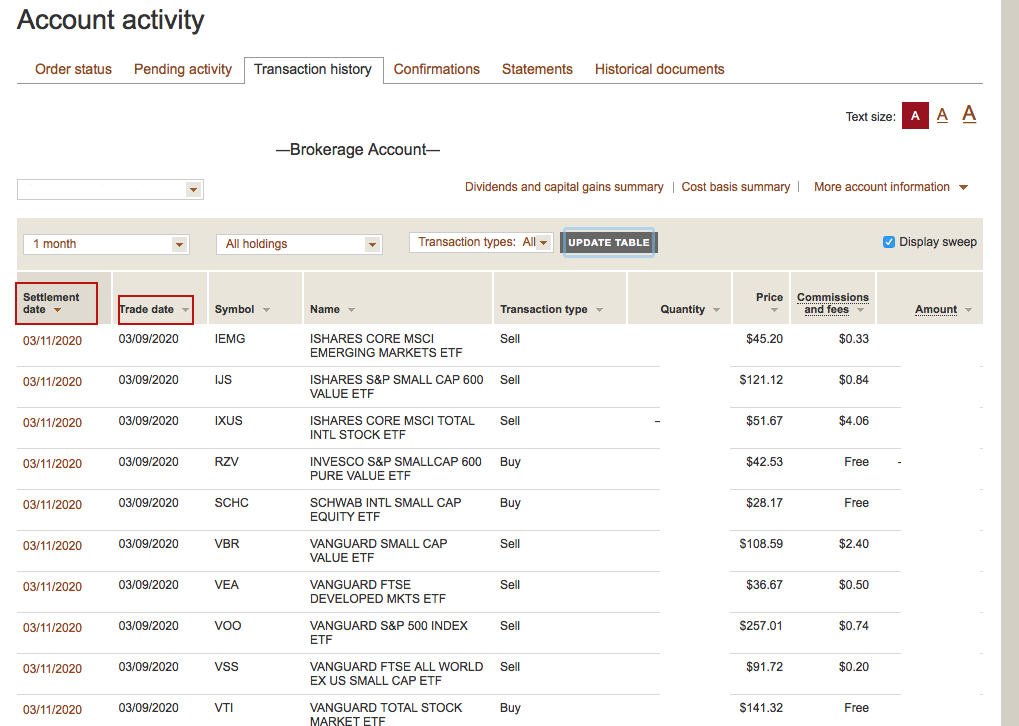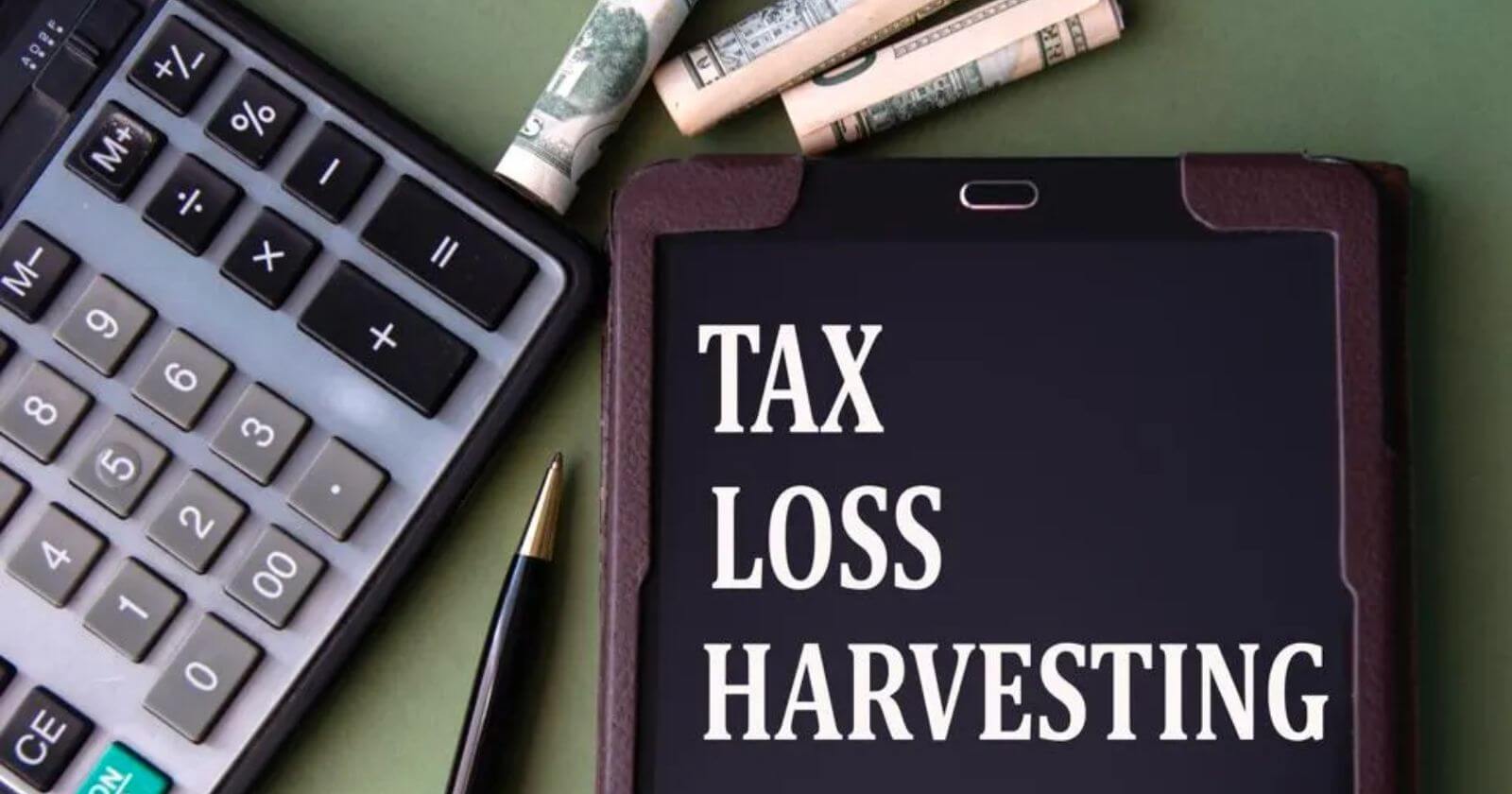Sometimes, it’s a Tax Loss Harvesting bonanza out there! You harvest and then it falls again, significantly enough that you want to harvest some more losses.
March Madness
In March 2020, thanks to the COVID-19 pandemic, markets crashed from their lofty gains of 11 years and slid into bear territory. I tax loss harvested (TLH hereon) $60,000 the first half of March. And the way it’s looking now, there may be some more coming before we are done with this. Let me break down how it played out for me:
Tax Loss Harvesting Small Cap Value Holdings
On March 2nd, I had a little over $5000 in losses in my small cap value holding, VIOV (Vanguard S&P Small Cap600 ETF). I sold it and went to VBR (Vanguard Small Cap Value ETF)-which is my default holding. I had been out of it for the last few months due to a prior TLH session in 2019.
On March 9th, S&P500 slid 7%, markets went into a 15 minute time-out. I exchanged the VBR I bought the previous week and went into RZV (Rydex S&P Small Cap 600 ETF). I harvested a $9600 loss.
Yet, there was more. The market entered bear territory at the end of the week. Another 15 minute trading halt. And I TLH’ed another $22,000 going from RZV to VTWV (Vanguard Russell 2000 Value ETF).
Tax Loss Harvesting Total International Stock Market
I had a $12,000 loss in my Total International holding IXUS (iShares Core MSCI Total International Stock ETF) and about a $1500 loss in VEA (Vanguard FTSE Developed Markets ETF). I sold them and went to VXUS (Vanguard Total Stock Market ETF). I was in IXUS and VEA thanks to a prior TLH session back in August 2019. VXUS is my default position for Total International Stock Market. And I was hoping to stay in it.
But markets tumbled a second time that week. I had $24000 in losses in VXUS- too much to ignore. I would to have to move again. I sold VXUS and bought VEU (Vanguard FTSE All-World Ex-US ETF). I checked my Transaction history to make sure that the trade had settled.

And then some more…
While I was at it and my Cost Basis screen was bleeding red, I TLH’ed my International Small Cap holdings from VSS (Vanguard FTSE All-World ex-US Small Cap ETF) to SCHC (Schwab International Small Cap Equity ETF); my Emerging Market ETF: IEMG (iShares Core MSCI Emerging Market ETF) to VWO (Vanguard Emerging Market Stock ETF) and a little bit of Total U.S. Stock Market VOO (Vanguard S&P500 ETF) to VTI (Vanguard Total Stock Market ETF). Is your head spinning yet? Mine certainly was, by the end of it.
The Case for Multiple Partners(!)
Originally, when people were tax loss harvesting, they sold a fund at a loss. then sat on the sidelines for the 31 days to pass to avoid the wash sale rule. This is no longer broadly recommended owing to the market recovering within those 31 days and you losing out on buying at the same low price.
Hence, you sell and buy right away. If this happens only once, you need only one TLH partner for each asset class you hold. But, market frenzy often comes in clusters within days and we often need to go from one replacement fund to another. So, having a bunch of options in each asset class helps.
(TLH) Partners are not perfect
- In order to avoid the “substantially identical” rule of the IRS, it is best to TLH between funds that track different indexes. So, you do not get the exact same exposure. For example, for Total U.S. Stock Market, my default holding is VTI, which tracks the CRSP Total U.S. Stock Market Index. A perfectly good TLH partner for it is VOO- which tracks the S&P500. The S&P500 index includes the 500 largest companies in the U.S., not the entire market (though it is about 75% of the total market). But the two have nearly identical returns and a greater than 99% correlation. Similarly for Small Cap indexes, not all of them are created equal.
- Even within the same or closely correlated benchmarks, different funds have different tracking errors. Some of them do a better job of tracking their benchmarks than others do.
- The replacement fund may have a higher expense ratio. This again is usually not a big deal because the commonly held asset classes in a Boglehead-style portfolio all have fairly low expense ratios and a few percentage points do not matter.
- They may differ in tax efficiency. The difference should not be much since they are all passively managed index funds and belong to the same asset class, but it’s there. It is because of differences in dividends distributed and capital gains from sale of underlying assets. Dividends may be distributed by different funds at different times of the year. Or some funds may distribute them annually- which makes them less tax efficient if you happen to buy into them right before a dividend is distributed.
Despite these differences or drawbacks, you have to be prepared to hold the replacement funds for prolonged periods of time, until the opportunity to tax loss harvest (or donation or sale) presents itself.
TLH Partners for Total U.S. Stock Market
Large cap ETFs are often substituted for Total Market ETFs since Large Cap holdings account for over 90% of Total Stock Market indices.
Some options and their Expense Ratios (ER) are:
- VTI/VTSAX (Vanguard Total Stock Market ETF/fund), ER 0.03%, tracks CRSP U.S. Total Market Index
- VOO/VFIAX (Vanguard S&P 500 ETF/fund), ER 0.03%, tracks S&P 500
- VV/VLCAX (Vanguard Large Cap ETF/fund), ER 0.04%, tracks CRSP U.S. Large Cap Index
- FSKAX (Fidelity Total Stock Market Index Fund), ER 0.02%, tracks Dow Jones U.S. Total Stock Market Index
- FZROX (Fidelity Zero Total Market Index Fund), ER 0.0%, tracks Fidelity U.S. Total Investable Market Index
- ITOT (iShares Core S&P Total U.S. Stock Market ETF), ER 0.03%, tracks S&P Total Stock Market Index
- IVV (iShares Core S&P 500 ETF), ER 0.04%, tracks S&P 500
- IWV (iShares Russell 3000 ETF), ER 0.20% (expensive!), tracks Russell 3000 Index
- SCHB (Schwab U.S. Broad Market ETF), ER 0.03%, tracks Dow Jones U.S. Broad Stock Market Index
- SPY (SPDR S&P 500 ETF), ER 0.09%, tracks S&P 500
TLH Partners for Total International Stock Market
- VXUS/VTIAX (Vanguard Total International Stock ETF/fund), ER 0.08%, tracks FTSE Global All Cap ex US Index
- IXUS (iShares Total International Stock ETF/fund), ER 0.08%, tracks MSCI ACWI ex-U.S. Investable Market Index
- VEU/VFWAX (Vanguard All-World ex-U.S. ETF/fund), ER 0.08%, tracks FTSE All-World ex US Index +/- VSS/VFSAX (Vanguard All World ex-U.S. Small Cap ETF/fund), ER 0.11%, tracks FTSE Global Small Cap ex US Index
- VEA/VTMGX (Vanguard Developed Market ETF/fund), ER 0.05%, tracks FTSE Developed All Cap ex US Index + VWO/VEMAX (Vanguard Emerging Market ETF/fund), ER 0.10%, tracks FTSE Emerging Markets All Cap China A Inclusion Index
- EFA (iShares MSCI EAFE ETF), ER 0.32% (seriously expensive!), tracks MSCI EAFE (Europe, Australasia and Far East) Index +/- Emerging Market ETF
Points to Note:
- VEU is mostly large and mid-cap companies. So, it is often recommended to add on some VSS for small-cap exposure in 85-90%:10-15% ratio. This is not an exact science.
- Similarly, VEA is only Developed market. So, add on VWO for Emerging market exposure (70:30 is commonly quoted) for a truer Total International holding.
- SCHF (Schwab International Equity ETF), ER 0.06%, tracks FTSE Developed ex-U.S. Index. Therefore this, by itself, is not a good replacement fund for Total International Market because it excludes emerging markets.
- IEFA (iShares Core MSCI EAFE ETF), ER 0.07%, is likewise, a holding of large and mid-cap companies in developed markets, excluding U.S. and Canada.
TLH Partners for U.S. Small Cap Value Holdings
For those who add a value tilt to their portfolio, domestic small cap holdings offers a fantastic TLH opportunity. Whenever there is market volatility, along with International stocks, small cap stocks are often the first to tumble.
- VBR/VSIAX (Vanguard Small Cap Value ETF/fund), ER 0.07%, tracks CRSP US Small Cap Value Index
- VIOV (Vanguard S&P Small Cap 600 Value ETF), ER 0.15%, tracks S&P Small-Cap 600 Value Index
- VTWV (Vanguard Russell 2000 Value ETF), ER 0.15%, tracks Russell 2000
- IJS (iShares S&P Small Cap 600 Value ETF), ER 0.25%, tracks S&P Small Cap 600 Index
- RZV (S&P Small Cap 600 Value ETF), ER 0.35%, tracks S&P Small Cap 600 Index
- SLYV (SPDR S&P Small Cap 600 Value ETF), ER 0.15%, tracks S&P small Cap 600 Index
- VB (Vanguard Small Cap ETF), ER 0.05%, tracks CRSP US Small Cap Index. It does not focus on value stocks.
- IWM (iShares Russell 2000 ETF), ER 0.19%, tracks Russell 2000 Index
As you can see, this is a problem since a bunch of the ETFs above track the same index. It will likely NOT be reported by your brokerage as a wash sale. So, it depends on your risk tolerance whether you want to defend your position to the IRS, if it comes to that. There are no known instances of the IRS flagging a wash sale though.
Some other options:
These are either mid caps or small caps but without a value tilt.
- VOE/VMVAX (Vanguard Mid Cap Value ETF), ER 0.07%, tracks CRSP US Mid Cap Value Index: may be used in place of Small Cap holdings for a short duration if you are out of options
- IVOV (Vanguard S&P Mid Cap 400 Value ETF), ER 0.15%, tracks S&P Mid Cap 400
- IJJ (iShares S&P Mid Cap 400 Value ETF), ER 0.25%, tracks S&P Mid Cap 400 Index
TLH Partners for International Small Cap Value Holdings
- VSS/VFSAX (Vanguard FTSE All-World Ex-U.S. ETF/fund), ER 0.11%, tracks FTSE Global Small Cap ex US Index
- SCZ (iShares MSCI EAFE Small Cap ETF), ER 0.40%, tracks MSCI EAFE Small Cap Index
- SCHC (Schwab International Small Cap Equity ETF), ER 0.11%, tracks FTSE Developed Small Cap ex-U.S. Liquid Index
- FNDC (Schwab Fundamental International Small Company Index ETF), ER 0.39%, tracks Russell RAFI Developed ex US Small Company Index
- DLS (WisdomTree International Small Cap Dividend Fund), ER 0.58%
SCZ, SCHC, FNDC and DLS all limit themselves to small caps in developed markets only. VSS includes about 15-20% of Emerging Markets, too. Despite this, they are highly correlated and works for TLH purposes.
TLH Partners for Emerging Markets Holdings
- VWO/VEMAX (Vanguard Emerging Market ETF/fund), ER 0.10%, tracks FTSE Emerging Markets All Cap China A Inclusion Index
- IEMG (iShares Emerging Markets ETF), ER 0.14%, tracks Core MSCI Emerging Market Index
- SCHE (Schwab Emerging Market Equity ETF), ER 0.11%, tracks FTSE Emerging Market Index
- SPEM (SPDR Portfolio Emerging Market ETF), ER 0.11%, tracks S&P Emerging Market Index
I hope this list helps you harvest some of your tax losses when market jitters present the opportunity. There are many nuanced differences between these funds and the discussion could get as detailed as you want it to. however, these options work pretty well most of the time. Happy TLH’ing!


